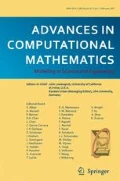Abstract
We present a hybrid asymptotic/numerical method for the accurate computation of single- and double-layer heat potentials in two dimensions. It has been shown in previous work that simple quadrature schemes suffer from a phenomenon called “geometrically induced stiffness,” meaning that formally high-order accurate methods require excessively small time steps before the rapid convergence rate is observed. This can be overcome by analytic integration in time, requiring the evaluation of a collection of spatial boundary integral operators with non-physical, weakly singular kernels. In our hybrid scheme, we combine a local asymptotic approximation with the evaluation of a few boundary integral operators involving only Gaussian kernels, which are easily accelerated by a new version of the fast Gauss transform. This new scheme is robust, avoids geometrically induced stiffness, and is easy to use in the presence of moving geometries. Its extension to three dimensions is natural and straightforward, and should permit layer heat potentials to become flexible and powerful tools for modeling diffusion processes.
Similar content being viewed by others
References
Alpert, B.K.: Hybrid Gauss-trapezoidal quadrature rules. SIAM J. Sci. Comput. 20, 1551–1584 (1999). (electronic)
Atkinson, K.E.: The numerical solution of integral equations of the second kind. Cambridge University Press, New York (1997)
Bremer, J., Rokhlin, V., Sammis, I.: Universal quadratures for boundary integral equations on two-dimensional domains with corners. J. Comput. Phys. 229, 8259–8280 (2010)
Davis, P.J., Rabinowitz, P.: Methods of numerical integration. Academic Press, San Diego (1984)
Greengard, L., Lee, J. -Y.: Stable and accurate integral equation methods for scattering problems with multiple interfaces in two dimensions. J. Comput. Phys. 231, 2389–2395 (2012)
Greengard, L., Lin, P.: Spectral approximation of the free-space heat kernel. Appl. Comput. Harmon. Anal. 9, 83–97 (2000)
Greengard, L., Strain, J.: A fast algorithm for the evaluation of heat potentials. Comm. Pure Appl. Math. 43, 949–963 (1990)
Greengard, L., Strain, J.: The fast Gauss transform. SIAM, J. Sci. Statist. Comput. 12, 79–94 (1991)
Guenther, R.B., Lee, J.W.: Partial differential equations of mathematical physics and integral equations. Prentice Hall, Inglewood Cliffs (1988)
Helsing, J., Ojala, R.: Corner singularities for elliptic problems: integral equations, graded meshes, and compressed inverse preconditioning. J. Comput. Phys. 227, 8820–8840 (2008)
Hille, E.: A class of reciprocal functions. Annals of Mathematics: Second Series 27, 427–464 (1926)
Li, J.-R., Greengard, L.: High order accurate methods for the evaluation of layer heat potentials. SIAM J. Sci. Comput. 31, 3847–3860 (2009)
Lin, P.: On the numerical solution of the heat equation in unbounded domains. PhD thesis, New York University, New York (1993)
Pogorzelski, W.: Integral equations and their applications. Pergamon Press, Oxford (1966)
Sampath, R.S., Sundar, H., Veerapaneni, S.: Parallel fast gauss transform. In: SC ’10: Proceedings of the ACM/IEEE International Conference for High Performance Computing, Networking, Storage and Analysis, New Orleans, LA, pp. 1–10 (2010)
Strain, J.: Fast adaptive methods for the free-space heat equation. SIAM J. Sci. Comput. 15, 185–206 (1994)
Tausch, J.: A fast method for solving the heat equation by layer potentials, J. Comput. Phys. (2007)
Tausch, J., Weckiewicz, A.: Multidimensional fast Gauss transforms by Chebyshev expansions. SIAM J. Sci. Comput. 31, 3547–3565 (2009)
Trefethen, L.N.: Numerical computation of the Schwarz-Christoffel transformation. SIAM J. Sci. Stat. Comput. 1, 82–102 (1980)
Wang, J., Greengard, L.: An adaptive fast Gauss transform in two dimensions. SIAM J. Sci. Comput. 40, A1274–A1300 (2018)
Acknowledgments
We would like to thank Alex Barnett and Shidong Jiang for several useful conversations.
Author information
Authors and Affiliations
Corresponding author
Additional information
Communicated by: Zydrunas Gimbutas
This work was supported in part by the Applied Mathematical Sciences Program of the U.S. Department of Energy under Contract DEFGO288ER25053 and by the RiskEcon Lab for Decision Metrics at the Courant Institute
Appendix: A Stirling’s formula, Cramer’s inequality, and Gauss-Legendre quadrature
Appendix: A Stirling’s formula, Cramer’s inequality, and Gauss-Legendre quadrature
In the proof of Theorem 2, we make use of Stirling’s formula.
From this, it is staightforward to derive the following:
Corollary 1
Letn ∈N,we have the following:
where C > 0 is a constant.
We also use Cramer’s inequality [11].
Lemma 1
Lethsn(t) be the nth order Hermite function, defined by the following:
Then
where K is some constant with numerical value K ≤ 1.09.
The following lemma is a direct consequence of Leibniz’s product rule for differentiation.
Lemma 2
Let \(F(t)=\frac {1}{t}\) and \(f(t)=\frac {1}{\sqrt {t}}\) . Then, we have the following:
Finally, we state the standard error estimate for Gauss-Legendre quadrature [4].
Lemma 3
Letf ∈ C2n([a,b]) and let {xs1,⋯ ,xsn} and {ws1,⋯ ,wsn} be the Gauss-Legendre nodes and weights scaled to[a,b].If we denote, the quadrature error byEsn(f),we have the following:
whereξ ∈ [a,b].
Rights and permissions
About this article
Cite this article
Wang, J., Greengard, L. Hybrid asymptotic/numerical methods for the evaluation of layer heat potentials in two dimensions. Adv Comput Math 45, 847–867 (2019). https://doi.org/10.1007/s10444-018-9641-5
Received:
Accepted:
Published:
Issue Date:
DOI: https://doi.org/10.1007/s10444-018-9641-5



